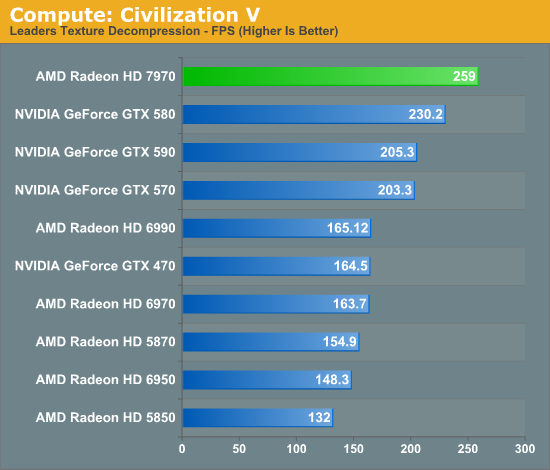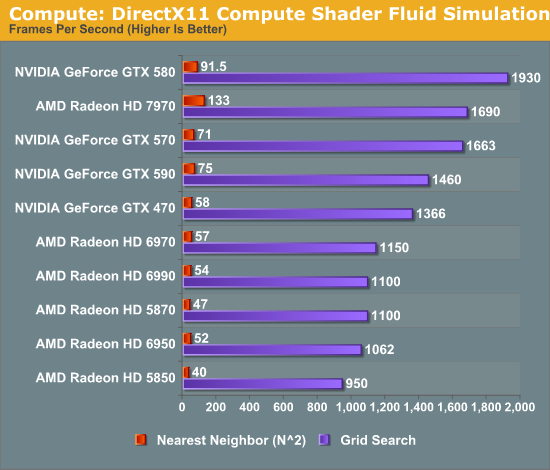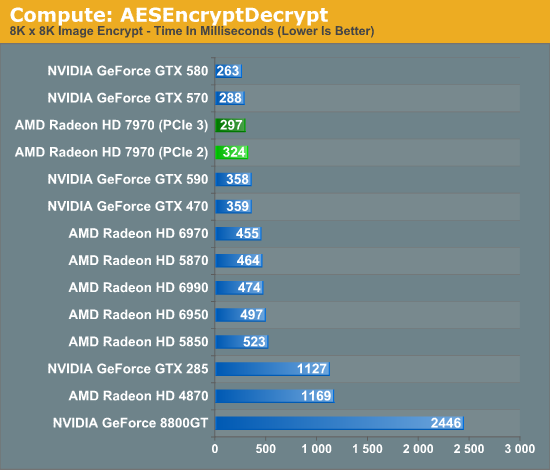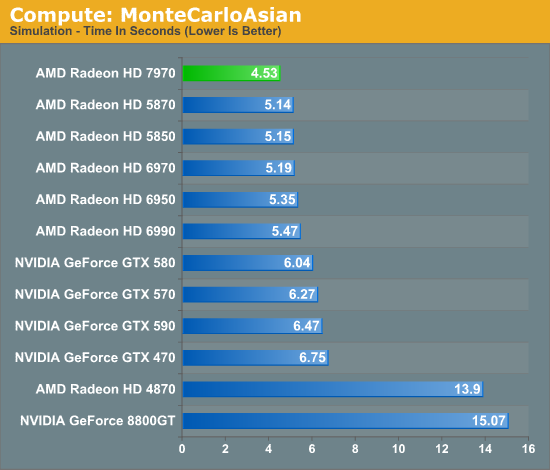AMD Radeon HD 7970 Review: 28nm And Graphics Core Next, Together As One
by Ryan Smith on December 22, 2011 12:00 AM EST- Posted in
- GPUs
- AMD
- Radeon
- ATI
- Radeon HD 7000
Compute: The Real Reason for GCN
Moving on from our game tests we’ve now reached the compute benchmark segment of our review. While the gaming performance of the 7970 will have the most immediate ramifications for AMD and the product, it is the compute performance that I believe is the more important metric in the long run. GCN is both a gaming and a compute architecture, and while its gaming pedigree is well defined its real-world compute capabilities still need to be exposed.
With that said, we’re going to open up this section with a rather straightforward statement: the current selection of compute applications for AMD GPUs is extremely poor. This is especially true for anything that would be suitable as a benchmark. Perhaps this is because developers ignored Evergreen and Northern Islands due to their low compute performance, or perhaps this is because developers still haven’t warmed up to OpenCL, but here at the tail end of 2011 there just aren’t very many applications that can make meaningful use of the pure compute capabilities of AMD’s GPUs.
Aggravating this some is that of the applications that can use AMD’s compute capabilities, some of the most popular ones among them have been hand-tuned for AMD’s previous architectures to the point that they simply will not run on Tahiti right now. Folding@Home, FLACC, and a few other candidates we looked into for use as compute benchmarks all fall under this umbrella, and as a result we only have a limited toolset to work with for proving the compute performance of GCN.
So with that out of the way, let’s get started.
Since we just ended with Civilization V as a gaming benchmark, let’s start with Civilization V as a compute benchmark. We’ve seen Civilization V’s performance skyrocket on 7970 and we’ve theorized that it’s due to improvements in compute shader performance, and now we have a chance to prove it.

And there’s our proof. Compared to the 6970, the 7970’s performance on this benchmark has jumped up by 58%, and even the previously leading GTX 580 is now beneath the 7970 by 12%. GCN’s compute ambitions are clearly paying off, and in the case of Civilization V it’s even enough to dethrone NVIDIA entirely. If you’re AMD there’s not much more you can ask for.
Our next benchmark is SmallLuxGPU, the GPU ray tracing branch of the open source LuxRender renderer. We’re now using a development build from the version 2.0 branch, and we’ve moved on to a more complex scene that hopefully will provide a greater challenge to our GPUs.

Again the 7970 does incredibly well here compared to AMD’s past architectures. AMD already did rather well here even with the limited compute performance of their VLIW4 architecture, and with GCN AMD once again puts their old architectures to shame, and puts NVIDIA to shame too in the process. Among single-GPU cards the GTX 580 is the closest competitor and even then the 7970 leads it by 72%. The story is much the same for the 7970 versus the 6970, where the 7970 leads by 74%. If AMD can continue to deliver on performance gains like these, the GCN is going to be a formidable force in the HPC market when it eventually makes its way there.
For our next benchmark we’re once again looking at compute shader performance, this time through the Fluid simulation sample in the DirectX SDK. This program simulates the motion and interactions of a 16k particle fluid using a compute shader, with a choice of several different algorithms. In this case we’re using two of them: a highly optimized grid search that Microsoft based on an earlier CUDA implementation, and an (O)n^2 nearest neighbor method that is optimized by using shared memory to cache data.

There are many things we can gather from this data, but let’s address the most important conclusions first. Regardless of the algorithm used, AMD’s VLIW4 and VLIW5 architectures had relatively poor performance in this simulation; NVIDIA meanwhile has strong performance with the grid search algorithm, but more limited performance with the shared memory algorithm. 7970 consequently manages to blow away the 6970 in all cases, and while it can’t beat the GTX 580 at the grid search algorithm it is 45% faster than the GTX 580 with the shared memory algorithm.
With GCN AMD put a lot of effort into compute performance, not only with respect to their shader/compute hardware, but with the caches and shared memory to feed that hardware. I don’t believe we have enough data to say anything definitive about how Tahiti/GCN’s cache compares to Fermi’s cache, this benchmark does raise the possibility that GCN cache design is better suited for less than optimal brute force algorithms. In which case what this means for AMD could be huge, as it could open up new HPC market opportunities for them that NVIDIA could never access, and certainly it could help AMD steal market share from NVIDIA.
Moving on to our final two benchmarks, we’ve gone spelunking through AMD’s OpenCL archive to dig up a couple more compute scenarios to use to evaluate GCN. The first of these is AESEncryptDecrypt, an OpenCL AES encryption routine that AES encrypts/decrypts an 8K x 8K pixel square image file. The results of this benchmark are the average time to encrypt the image over a number of iterations of the AES cypher.

We went into the AMD OpenCL sample archives knowing that the projects in it were likely already well suited for AMD’s previous architectures, and there is definitely a degree of that in our results. The 6970 already performs decently in this benchmark and ultimately the GTX 580 is the top competitor. However the 7970 still manages to improve on the 6970 by a sizable degree, and accomplishes this encryption task in only 65% the time. Meanwhile compared to the GTX 580 it trails by roughly 12%, which shows that if nothing else Fermi and GCN are going to have their own architectural strengths and weaknesses, although there’s obviously some room for improvement.
One interesting fact we gathered from this compute benchmark is that it benefitted from the increase in bandwidth offered by PCI Express 3.0. With PCIe 3.0 the 7970 improves by about 10%, showcasing just how important transport bandwidth is for some compute tasks. Ultimately we’ll reach a point where even games will be able to take full advantage of PCIe 3.0, but for right now it’s the compute uses that will benefit the most.
Our final benchmark also comes from the AMD OpenCL archives, and it’s a variant of the Monte Carlo method implemented in OpenCL. Here we’re timing how long it takes to execute a 400 step simulation.

For our final benchmark the 7970 once again takes the lead. The rest of the Radeon pack is close behind so GCN isn’t providing an immense benefit here, but AMD still improves upon the 6970 by 14%. Meanwhile the lead over the GTX 580 is larger at 33%.
Ultimately from these benchmarks it’s clear that AMD is capable of delivering on at least some of the theoretical potential for compute performance that GCN brings to the table. Not unlike gaming performance this is often going to depend on the task at hand, but the performance here proves that in the right scenario Tahiti is a very capable compute GPU. Will it be enough to make a run at NVIDIA’s domination with Tesla? At this point it’s too early to tell, but the potential is there, which is much more than we could say about VLIW4.










292 Comments
View All Comments
Ryan Smith - Thursday, December 22, 2011 - link
Since 1920x1200 has already been commented on elsewhere I'm just going to jump right to your comment on minimum FPS.I completely agree, and we're trying to add it where it makes sense. A lot of benchmarks are wildly inconsistent about their minimum FPS, largely thanks to the fact that minimum FPS is an instantaneous data point. When your values vary by 20%+ per run (as minimums often do), even averaging repeated trials isn't nearly accurate enough to present meaningful results.
CeriseCogburn - Thursday, March 8, 2012 - link
HardOCP shows long in game fps per second charts that show dips and bottom outs are more than one momentary lapse and often are extended time periods of lowest frame rate runs, so I have to respectfully disagree.Perhaps the fault is fraps can show you a single instance of lowest frame rate number, and hence it's the analysis that utterly fails - given the time constraints that were made obvious, it is also clear that the extra work it would take for an easily reasoned and reasonable result that is actually of worthy accuracy is not in the cards here.
thunderising - Thursday, December 22, 2011 - link
Okay. This card has left me thrilled, but wanting for more. Why?Well, for example, every reviewer has hit the CCC Core and Memory Max Limits, which turns into a healthy 10-12% performance boost, all for 10W.
What, legit reviews got it to 1165MHz core and 6550Mhz memory for a 21-24% increase in performance. Now that's HUGE!
I think AMD could have gone for something like this with the final clocks, to squeeze out every last bit of performance from this amazing card:
Core - 1050 MHz
Memory - 1500 MHz (6000MHz QDR)
This was not only easily achievable, but would have placed this card at a 8-10% increase in performance all for a mere <10W rise in Load Power.
Hoping for AIBs like Sapphire to show their magic! HD7970 Toxic, MmmmmmM...
Otherwise, fantastic card I say.
Death666Angel - Friday, December 23, 2011 - link
Maybe they'll do a 4870/4890 thing again? Launch the HD7970 and HD7970X2 and then launch a HD7990 with higher clocks later to counter nVidia.... Who knows. :-)Mishera - Sunday, December 25, 2011 - link
They've been doing it for quite some time now. Their plan has been to release a chip balancing die size, performance, and cost. Then later to compete on high end release a dual-chip card. Anand wrote on this a while ago with the rv770 story (http://www.anandtech.com/show/2679).Even looking at the picture of chip sizes, the 7970 is still a reasonable size. And this really was a brilliant move as though Nvidia has half the marketshare and does make a lot of money from their cards, their design philosophy has been hurting them a lot from a business standpoint.
On a side note, Amd really made a great choice by choosing to wait until now to push for general computing. Though that probably means more people to support development and drivers, which means more hiring which is the opposite way Amd has been going. It will be interesting to see how this dichotomy will develop in the future. But right now kudos to Amd.
CeriseCogburn - Thursday, March 8, 2012 - link
Does that mean amd is abandoning gamers as we heard the scream whilst Nvidia was doing thus ?I don't quite get it - now what nvidia did that hurt them, is praise worthy since amd did it, finally.
Forgive me as I scoff at the immense dichotomy...
"Perfect ripeness at the perfect time" - sorry not buying it....
privatosan - Thursday, December 22, 2011 - link
PRT is a nice feature, but there is an failure in the article:'For AMD’s technology each tile will be 64KB, which for an uncompressed 32bit texture would be enough room for a 4K x 4K chunk.'
The tile would be 128 x 128 texels; 4K x 4K would be quite big for a tile.
futrtrubl - Thursday, December 22, 2011 - link
I was going to comment on that too. A 4k x 4k x 32bit (4byte) texture chunk would be around 67MB uncompressed. For a 32bit texture you could only fit a 128x128 array in a 64KB chunk. An 8bit/pixel texture could be 4k*4kStonedofmoo - Thursday, December 22, 2011 - link
Thanks for the review. A request though...To the hardware sites doing these reviews, many of us in this day and age run dual monitor or more. It always frustrates in me in these reviews that we get a long write up on the power saving techniques the new cards use, and never any mention of it helps those of us running more than one display.
For those not in the know, if you run more than one display on all the current generations the cards do NOT downclock the GPU and memory nearly as much as they do on single montor configurations. This burns quite a lot more power and obviously kicks out more heat. No site ever mentions this which is odd considering so many of us have more than one display these days.
I would happily buy the card that finally overcomes this and actually finds a way of knocking back the clocks with multi-monitor setups. Is the new Radeon 7xxx series that card?
Galcobar - Thursday, December 22, 2011 - link
It's in the article, on the page entitled "Meet the Radeon 7970."Ryan also replied to a similar comment by quoting the paragraph addressing multi-monitor setups and power consumption at the top of page of the comments.
That's two mentions, and the answer to your question.